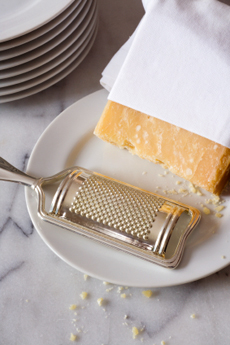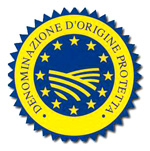

Parmesan is one of the best grating cheeses, making almost any dish taste better. Photo by Y. Yang | IST.
|
STEPHANIE ZONIS focuses on good foods and the people who produce them. KAREN HOCHMAN is Editorial Director of THE NIBBLE.
|
|
September 2007
Last Updated July 2012
|
 |
Grating Cheeses: It’s Great To Grate
The Italian Grating Cheeses—Asiago, Grana Padano, Parmigiano-Reggiano & Pecorino
- Click here to read other months’ Whey To Go columns
CAPSULE REPORT: It’s hard to think of a food that wouldn’t taste better with a bit of grated cheese. But which one should you buy? This thorough article reveals the differences among the great Italian grating cheeses. Yes, some are better than others for particular purposes, but the key is always what appeals to your own palate. By the way, these cheeses even work as ice cream—made into ice cream, though, not grated on top of it. (See our article on Cheese Ice Cream.)
Grating Cheese Overview
There are four Italian cheeses that are most often used for grating: Asiago, Grana Padano, Parmigiano-Reggiano and Pecorino Romano. All have been made for centuries—one for 1,000 years, one for 2,000 years. Although they range in complexity, and three are cow’s milk cheeses while one is a sheep cheese, they can be substituted one for the other. Although some people have strong preferences (e.g. Parmigiano-Reggiano with risotto), others might not know if Grana Padano or Asiago were being grated over their pasta. Still other people prefer the saltier and more pungent Pecorino Romano.
Which is the right cheese to use for your food? What else can you do with these cheeses besides grating them over pasta? As always, your palate will be your guide, but we’ll provide some basic information about each type of cheese. And yes, these graters are also great table cheeses.* For those seeking truly special specialty cheeses, there are an authentic kosher Parmigiano-Reggiano and Grana Padano, and an organic Parmigiano-Reggiano.
*A table cheese is, simply, a cheese eaten at the table—as part of a cheese board, on a sandwich or burger.
Name Protection
 All four cheeses are D.O.P. (Denominazione d’Origine Protetta) name-protected. This is a legal protection for the consumer that guarantees that you are buying an authentic Asiago, Grana Padano or Parmigiano-Reggiano, made by a trained artisan to exacting specifications. The consortium of producers that applies for name protection does so to protect the quality that the brand stands for, from imitators. In Italy, the D.O.P. mark guarantees, among other things, that: All four cheeses are D.O.P. (Denominazione d’Origine Protetta) name-protected. This is a legal protection for the consumer that guarantees that you are buying an authentic Asiago, Grana Padano or Parmigiano-Reggiano, made by a trained artisan to exacting specifications. The consortium of producers that applies for name protection does so to protect the quality that the brand stands for, from imitators. In Italy, the D.O.P. mark guarantees, among other things, that:
- The cheese was produced within a specific geographical area, from milk from specific herds of animals raised in the same area.
- The cheese was made using strictly defined methods that have been handed down over several centuries.
- The characteristics of the cheese that have been precisely defined: Its size, type of rind, texture and minimum fat content are adhered to strictly.
- The producers submit themselves to review by a control commission or consorzio, which guarantees the authenticity and quality of the products (and rejects those which are not up to standard).
Other European countries, including Portugal, use the D.O.P. designation—for wine, olive oil, meat, condiments and other food products in addition to cheese. In France, the analogous designation is known as A.O.C. (Appellation d’Origine Contrôlée), and in Spain it is D.O. (Denominación de Origen).
Continue To Page 2: Grated Cheese
Go To The Article Index Above
Lifestyle Direct, Inc. All rights reserved. Images are the copyright of their respective owners.

|





 All four cheeses are D.O.P. (Denominazione d’Origine Protetta) name-protected. This is a legal protection for the consumer that guarantees that you are buying an authentic Asiago, Grana Padano or Parmigiano-Reggiano, made by a trained artisan to exacting specifications. The consortium of producers that applies for name protection does so to protect the quality that the brand stands for, from imitators. In Italy, the D.O.P. mark guarantees, among other things, that:
All four cheeses are D.O.P. (Denominazione d’Origine Protetta) name-protected. This is a legal protection for the consumer that guarantees that you are buying an authentic Asiago, Grana Padano or Parmigiano-Reggiano, made by a trained artisan to exacting specifications. The consortium of producers that applies for name protection does so to protect the quality that the brand stands for, from imitators. In Italy, the D.O.P. mark guarantees, among other things, that: